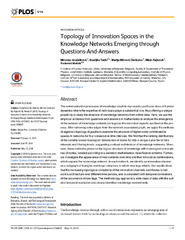Приказ основних података о документу
Topology of Innovation Spaces in the Knowledge Networks Emerging through Questions-And-Answers
| dc.creator | Anđelković, Miroslav | |
| dc.creator | Tadić, Bosiljka | |
| dc.creator | Mitrović Dankulov, Marija | |
| dc.creator | Rajković, Milan | |
| dc.creator | Melnik, Roderick | |
| dc.date.accessioned | 2018-03-01T16:54:49Z | |
| dc.date.available | 2018-03-01T16:54:49Z | |
| dc.date.issued | 2016 | |
| dc.identifier.issn | 1932-6203 | |
| dc.identifier.uri | https://vinar.vin.bg.ac.rs/handle/123456789/1085 | |
| dc.description.abstract | The communication processes of knowledge creation represent a particular class of human dynamics where the expertise of individuals plays a substantial role, thus offering a unique possibility to study the structure of knowledge networks from online data. Here, we use the empirical evidence from questions-and-answers in mathematics to analyse the emergence of the network of knowledge contents (or tags) as the individual experts use them in the process. After removing extra edges from the network-associated graph, we apply the methods of algebraic topology of graphs to examine the structure of higher-order combinatorial spaces in networks for four consecutive time intervals. We find that the ranking distributions of the suitably scaled topological dimensions of nodes fall into a unique curve for all time intervals and filtering levels, suggesting a robust architecture of knowledge networks. Moreover, these networks preserve the logical structure of knowledge within emergent communities of nodes, labeled according to a standard mathematical classification scheme. Further, we investigate the appearance of new contents over time and their innovative combinations, which expand the knowledge network. In each network, we identify an innovation channel as a subgraph of triangles and larger simplices to which new tags attach. Our results show that the increasing topological complexity of the innovation channels contributes to networks architecture over different time periods, and is consistent with temporal correlations of the occurrence of new tags. The methodology applies to a wide class of data with the suitable temporal resolution and clearly identified knowledge-content units. | en |
| dc.relation | info:eu-repo/grantAgreement/MESTD/Basic Research (BR or ON)/174014/RS// | |
| dc.relation | info:eu-repo/grantAgreement/MESTD/Basic Research (BR or ON)/171017/RS// | |
| dc.relation | Research Agency of the Republic of Slovenia [P1-0044], Natural Sciences and Engineering Research Council of Canada [213904] | |
| dc.relation.isreferencedby | https://vinar.vin.bg.ac.rs/handle/123456789/9420 | |
| dc.relation.isreferencedby | https://vinar.vin.bg.ac.rs/handle/123456789/9421 | |
| dc.rights | openAccess | en |
| dc.rights.uri | https://creativecommons.org/licenses/by/4.0/ | |
| dc.source | PLOS One | en |
| dc.title | Topology of Innovation Spaces in the Knowledge Networks Emerging through Questions-And-Answers | en |
| dc.type | article | en |
| dc.rights.license | BY | |
| dcterms.abstract | Мелник, Родерицк; Aнђелковић Мирослав; Тадиц, Босиљка; Данкулов, Марија Митровиц; Рајковић Милан; | |
| dc.citation.volume | 11 | |
| dc.citation.issue | 5 | |
| dc.identifier.wos | 000376588600150 | |
| dc.identifier.doi | 10.1371/journal.pone.0154655 | |
| dc.citation.other | Article Number: e0154655 | |
| dc.citation.rank | M21 | |
| dc.identifier.pmid | 27171149 | |
| dc.description.other | Supplementary material: Dataset [https://vinar.vin.bg.ac.rs/handle/123456789/9420] | |
| dc.description.other | Supplementary material: Dataset [https://vinar.vin.bg.ac.rs/handle/123456789/9421] | |
| dc.type.version | publishedVersion | |
| dc.identifier.scopus | 2-s2.0-84971237936 |

